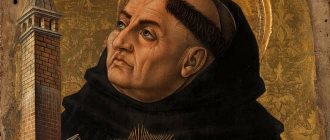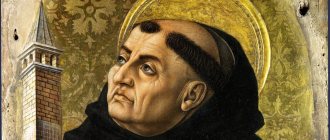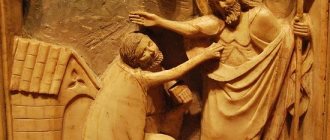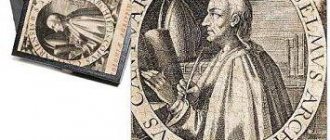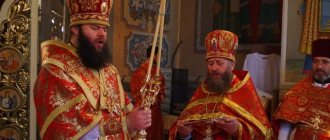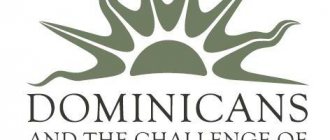"SUM OF THEOLOGY"
(Summa theologiae) - work of
Thomas Aquinas
. Written in Rome, Paris and Naples in 1265–1273. Thomas tried to systematize the results of his works and present them in a fairly accessible and concise form, primarily for theological students. It consists of three parts, with the second divided into two: pars prima, pars prima secundae, pars secunda secundae and pars tertia (according to the most common citation tradition, the parts are designated by Roman numerals - S. th. I, I–II, II–II, III); Each part is divided into questions, which in turn are divided into chapters - articles. The title of the chapter contains a controversial question, followed by several arguments that give conflicting answers to it, then a solution to the question and answers to the arguments. Each chapter is closely connected with all the others by a general system of argumentation and is provided with internal references. The Summa was not completed by Thomas due to an ecstatic vision he experienced, after which he stopped writing. The work was completed by Reginald of Piperno, Thomas's secretary and friend, based on the available materials. The complete Summa Theologica contains 38 treatises, 612 questions, divided into 3120 chapters, in which about 10 thousand arguments are discussed.
In the Summa Theologica, Thomas sought to cover as much as possible both fundamental general problems and extremely specific issues. The work includes almost all the main sections of philosophy - ontology, epistemology, ethics (their unity is justified by the doctrine of the “reversibility” of existence, the true and the good) and, implicitly, aesthetics. However, unlike many of his contemporaries, Thomas does not pay much attention to logic and natural philosophy here. A significant part of the Summa is devoted to purely theological topics, although explored through philosophical apparatus, especially part III, devoted to the incarnation, acts and passion of Christ (questions 1-59) and the sacraments (60-90). Conducting a dialogue with various philosophical and theological concepts, Thomas most often turns to Aristotle, Augustine, Pseudo-Dionysius the Areopagite, Boethius (Plato’s philosophy is known to him only in the Neoplatonic interpretation).
Part I substantiates the need for theology as a science with its own purpose, subject and method of research (question 1), interpreted by Thomas as the science of the first cause and ultimate goal of all things (i.e., about God). Therefore, the Summa begins with an examination of the question of the existence of God, His essence and properties (2-43), and then considers the created world (44-109). From Part I, the most important philosophically are: five proofs of the existence of God (2), the doctrine of the coincidence of essence and existence in God (3), the concept of God as an Existence, which forms the core of the philosophy of Thomas (13–14), the concept of identity in God of existence, good (5) and one (11). The theory of “creation from nothing” was substantiated in Chap. 44–46; the foundations of epistemology are laid in the doctrine of ideas (15) and in the concept of truth as the “adequacy” of intellect and things (16–17), and the foundations of ethics are in the theory of evil as the “deprivation” of good (48–49). An important place is given to the doctrine of man as a being composed of spiritual and bodily substance (75), analysis of the nature of the human soul and its essential unity with the body (76), study of the relationship between the intellectual and desiring abilities of the soul, on the basis of which Thomas proves that man has freedom will
(83) and develops a theory of knowledge that describes the movement from the empirical perception of individual concrete things to extremely abstract knowledge (84–89).
The most extensive part II, divided into parts I–II and II–II, contains an elaborate treatise on anthropology and ethics. Parts I-II begin with the definition of man's ultimate goal (1), which is to achieve the highest happiness - the contemplation of God (2-5), and it is the method of achieving this goal that determines the analysis of human abilities and actions. Action is considered as a complex unity of voluntary and involuntary, intellectual and volitional, internal intentions and external circumstances, and each of these moments determines the presence of good or evil in a particular act (6–21). Having thoroughly analyzed the passions of the soul (love and hatred, desire and aversion, pleasure and pain, hope and despair, courage and fear, anger (22–48), Thomas proceeds to define established inclinations (habitus), virtuous and sinful (49–89) , and concludes this part with a treatise on “natural” and human laws based on eternal, divine law (90–95).
In II-II, Thomas analyzes the virtues and abilities of man and their opposite sinful inclinations, in particular such phenomena as hope (17), despair (20), joy (28), fear (125), splendor (134), anger ( 158), curiosity (167), etc.; he pays attention to such unusual phenomena as foreseeing the future (171–174), ecstatic states (175), etc. At the end of this part, Thomas again turns to asserting the superiority of the contemplative type of life over the active one (179–182). The Summa Theologica quickly gained wide popularity, and the number of manuscript copies, editions and translations can hardly be counted. The first printed publication (parts of the secunda secundae) was made by Peter Schaeffer, a publisher from Mainz, in 1467, and the first complete edition was carried out in Basel in 1485. It was the Summa Theologica that had the most powerful influence on the development of neo-Thomism
(E. Gilson, J. Maritain) and on the design of Catholic theology.
Editions:
1. S. Thomae Aquinatis Doctoris Angeli, Opera Omnia, lussu impensaque Leonis XIII, PM edita, vol. VI–XII. Rome, 1918–30; vol. XVI includes an index to the Summa Theologica and the Summa against the Gentiles; Summa Theologiae. Torino, 1988;
2. in the lane in English. language: Thomas Aquinas.
Summa Theologica. L., 1912–36; L–N. Υ., 1964–73;
3. on it. language: Thomas von Aquin.
Summe der Theologie. Lpz., 1934;
4. in Russian trans.: individual chapters in the book: Anthology of world philosophy: in 4 volumes, vol. 1, part 2. M., 1969 (translated by S.S. Averintsev);
5. the same in the book: Borgosh Yu.
Thomas Aquinas. M., 1975;
6. “Symbol” (Paris), 1995, No. 3;
7. individual questions in the journal. “Logos” (M.), 1991, No. 2 (translated by M.A. Gartsev);
8. “VF”, 1997, No. 9, p. 163–178 (translated by K.V. Bandurovsky).
Indexes:
1. Deferrari RJ, Barry, Sister M. Inviolala and McGuiness I.
A Lexicon of St. Thomas Aquinas, based on The Summa Theologica and Selected Passages of His Other Works. Wash., 1949;
2. Schutz L.
Thomas-Lexicon.
Paderborn, 1895 (reprint: NY, 1949). See also lit. to Art. Thomas Aquinas
.
K.V. Bandurovsky
Scholastic philosophy. Thomas Aquinas. "Summa Theology". Controversy between nominalism and realism
Scholastic philosophy (from the Greek schola - school, scientist) is the second of the two main periods of Christian medieval philosophy.
Scholasticism was developed primarily in Western Europe under the auspices of the Catholic Church, in a single cultural space characterized by a common faith and language of religion and education (Latin), in church centers, monasteries, as well as in secular schools (from the 11th century) and universities (from the 12th century). -XIII centuries).
In scholasticism, there is a period of formation (IX-X centuries), early, mature and late scholasticism. In early scholasticism (XI-XII centuries), the Platonic-Augustinian direction predominates. Its largest representatives are Anselm of Canterbury (1033-1109) and Peter (Pierre) Abelard (1079-1142) .
In mature scholasticism (13th century), the orientation towards Aristotelianism takes over,
which is given an orthodox Christian character by the efforts of the outstanding thinkers of the Dominican Order,
Albertus Magnus (1193-1280) and his disciple Thomas Aquinas. The Dominicans were opposed by the scholastics of the Franciscan order Roger Bacon (1214-1294), John Dune Scotus (1266-1308), who remained committed to Augustinian voluntarism.
Late scholasticism (XIV-XV centuries) is a time of crisis in medieval philosophy, when there is a opposition between philosophy and theology, reason and faith, will and intellect, dogmas of religion and the principles of science; nominalism triumphs. Philosophy begins to have its own domain; it ceases to be the servant of theology. These processes find their highest expression in the work of William of Ockham (c.1300-1349).
Scholastic philosophy is characterized by the fact that, on the basis of the religious dogma and church orthodoxy developed in the era of patristics, the scholastics created in a rational way, widely using the techniques of formal logic, the method of deduction, speculative systems and encyclopedic collections of various knowledge - sums.
In addition, scholasticism is distinguished by commentary (systematization was based on commentary on texts that had indisputable authority - the Holy Scriptures and the writings of the “Church Fathers”) and didacticism (giving theoretical constructs the form of educational material). The feudal system of life was based in Western Europe on the Christian doctrine, which sanctified the individual and work, the interaction of church and secular authorities, complex legal ties that fixed the vassal and corporate structure, and rational forms of economic management. All this contributed to the preservation, and in some directions, the development of ancient, especially Roman, traditions of jurisprudence, rationalism, historicism, and psychologism
, partly -
individualism.
Even the relationship God - man - the world was then largely perceived as legal, and philosophical argumentation acquired the features of a legal one. Theoretical activity was regarded as an important component of serving God. The largest orthodox scholastics, for example Anselm of Canterbury, Thomas Aquinas, were canonized by the Catholic Church. Scholasticism was opposed by mystical philosophy, in the West - oppositional, in the Christian East
- more
influential,
since here the spiritual, cultural and socio-political conditions were not conducive to the development of jurisprudence, individualism and rationalism. However, in the East there was also a place for scholastic philosophizing.
The scholastics conducted the most heated debates on the problems of faith and reason and universals. The “Golden Age” of scholasticism was the XIII, in which grandiose theological and philosophical constructions were erected, representing all things as a harmonious, rationally ordered unity in plurality. The philosophy of Thomas Aquinas is considered the most perfect of these constructions .
Thomas Aquinas (Aquinas) (1224/5-1274), nicknamed the Angelic Doctor (Dr. Angelicus) for his extraordinary power of thought, came from an aristocratic German-Italian family and was a Dominican monk from the age of 19. He created the most influential philosophical doctrine in the Catholic world ( Thomism ), which in the form of neo-Thomism was recognized from the 2nd half. XIX century before the beginning XXI century official philosophy of Catholicism.
The main works of Thomas - " Summa Theology"
", "
Summa against the pagans
"
(its other name is "Summa Philosophy"), as well as the work "
On the Government of Sovereigns ".
The philosophy of Aquinas develops in line with Ristotelianism and bears such features as life-affirming optimism, confidence in the possibility and significance of theoretical knowledge of the world, the presentation of everything that exists as unity in diversity, affirmation of the value of a single, individual existence with its special place in the general order.
Thomas Aquinas exalts man, claiming that the world was created for his sake. The philosopher strives to present a harmonious relationship: God - man - nature; existence - essence; mind - will; faith - knowledge; soul - body; individual - society; morality is right; church - state. In Thomas's system, ancient rationalism, jurisprudence, and individualism, along with Christian theopentrism and personalism, were continued.
Thomas accepts what was already decided by the 13th century. The difference between theology and philosophy, the path of the former
- from God to the world, from cause to effects,
the second
- from the world to God, from effects to causes. The spheres of reason and faith partly overlap.
Some dogmas are super-reasonable (for example, about the Trinity), but some rational arguments can be given to substantiate the dogmas.
Guided by the ideas of Aristotelian metaphysics, Thomas puts forward rational arguments in favor of the existence of God. These are cosmological and teleological proofs. The philosopher does not explicitly resort to an ontological argument, believing that his existence cannot be deduced from the concept of God: since the essence of God is unknowable, the human mind is deprived of the concept of him. The essence of Thomas Aquinas's five proofs is this: there is a hierarchy in the world:
1 sources of motion, which means that at its top there must be an external prime mover;
2 producing causes, they must go back to the final producing cause;
3 necessary, the limit here should be unconditional necessity;
4 perfect, its crown should be absolute perfection;
5 goals, they must rise to a higher goal. And the prime mover, the primary producing cause, unconditional necessity, absolute perfection, i.e., Thomas concludes, “the rational being that sets the goal for everything that happens in nature […] we call God.”
On the problem of universals
Thomas Aquinas, following Aristotle, takes the position of realism. He believes that general concepts exist in three ways:
to things (as patterns in the mind of God);
in things (as their essence);
after things (in the human mind as concepts).
Read online “Summa Theologica. Part I. Questions 1-43"
Thomas Aquinas
Sum of Theology. Volume I. Questions 1-43
Treatise on Sacred Doctrine
Question 1. The essence and meaning of sacred teaching
[Discourse] about sacred teaching, what it should be and what we should strive for, set out in ten sections.
Since we understand that our research is subject to certain limitations, first of all it is necessary to understand about the teaching itself: what it should be and what it should be strived for.
Regarding this, ten points are examined: 1) whether it is necessary; 2) whether it is science; 3) whether it is one [science] or many; 4) whether it is speculative or of an applied nature; 5) how does it relate to other sciences; 6) whether it is the same as wisdom; 7) whether God can be its object; should it be evidentiary; 9) whether it can use metaphorical or symbolic expressions; 10) is it therefore possible, according to this teaching, to explain the Holy Scriptures in many senses?
2) whether it is science; 3) whether it is one [science] or many; 4) whether it is speculative or of an applied nature; 5) how does it relate to other sciences; 6) whether it is the same as wisdom; 7) whether God can be its object; should it be evidentiary; 9) whether it can use metaphorical or symbolic expressions; 10) is it therefore possible, according to this teaching, to explain the Holy Scriptures in many senses?
Section 1. Is any doctrine necessary besides the philosophical?
With the first [position], the situation is as follows.
But even those truths about God that the human mind is capable of exploring must necessarily be taught to people through divine revelation, for otherwise the divine truths accessible to understanding would become the property of a few, and even then not immediately and with an admixture of considerable errors. Meanwhile, a person’s complete salvation, which is found in God, completely depends on his knowledge of these truths. Therefore, in order for people to achieve salvation more successfully and more confidently, it is necessary that divine truths be taught to them through divine revelation. It is therefore clear that in addition to philosophical science, based on reason, there must also be a sacred science taught through revelation.
Answer to objection 2. Differences in methods of knowledge create the diversity of sciences. Both an astronomer and a physicist can come to the same conclusion, for example, that the earth is round; but the astronomer will come to this mathematically (i.e., [reasoning] separately from matter), and the physicist will always have matter in mind. From this it follows: there is no reason to believe that while other things can be comprehended by philosophical science, insofar as they [in general] can be known by natural reason, they at the same time cannot be taught to us through another science, insofar as they are revealed in revelation. Therefore, it is clear that theology based on sacred teaching is qualitatively different from theology that is part of philosophical science.
Section 2. Is sacred teaching science?
The situation with the second [position] is as follows.
Objection 2. Moreover, [no] science considers individual things. Sacred science deals with individual things, for example, with the acts of Abraham, Isaac, Jacob, etc. Therefore, it is clear that sacred teaching is not science.
.
I answer: sacred teaching is science. You should know that there are two types of sciences. Some proceed from propositions that are obvious in the light of natural reason, such as arithmetic, [geometry], and the like. Others proceed from principles that are known in the light of other, higher sciences: such is the theory of perspective, based on the provisions explained by geometry, and the theory of music, based on the provisions established by arithmetic. Sacred teaching also belongs to this kind of science: this science proceeds from provisions established in the light of the highest science taught by God himself and those who have been honored with bliss. Just as a musician accepts on faith the principles proposed to him by a mathematician, so sacred science is entirely based on the principles taught to it by God.
Answer to objection 1. The provisions of any science are either self-evident, or are the conclusions of another, higher science; as has been shown, such are the essence and provisions of the sacred doctrine.
Reply to Objection 2. Sacred teaching deals with individual things, not because it is fundamentally guided by them, but either because through them it shows examples of righteous life (like the moral sciences), or because it thus establishes through whom exactly what was taught to us divine revelation that underlies scripture or teaching.
Section 3. Is sacred teaching one science?
With the third [position] the situation is as follows.
Objection 2. Moreover, the sacred doctrine speaks of angels, corporeal creatures and mortal men. But all these are subjects of various philosophical sciences. From this it is clear that sacred teaching cannot be one science.
I answer: sacred teaching is one science. The unity of abilities or skills should be understood in accordance with the object, not materially, but from the point of view of the formal definition of the object; for example, a man, a donkey and a stone are a unity from the point of view of the formal definition “colored”; “color” itself is a formal object of vision. From this it is clear that since the Holy Scripture considers all things from the point of view of their formal definition as manifestations of divinity, then everything that falls under the formal definition of “manifestation of divinity” is the object of one science, and therefore is included in the sacred teaching as one science
Reply to Objection 1. Sacred teaching does not consider God and the created as one thing, but primarily speaks of God, and of the created only to the extent that it relates to God as its cause and goal. Thus, the unity of this science is not violated.
Reply to Objection 2. Nothing prevents lower abilities or skills, divided according to any criterion, from falling under [one] higher ability or skill, which [higher ability or skill] is inherent in the object from the point of view of a more general formal definition. Thus the object of common sense is sensible [as such] because it is perceived as visible and audible...
